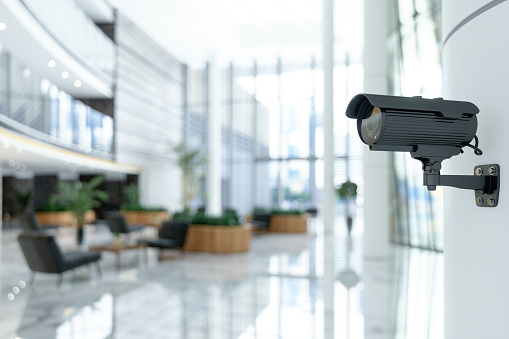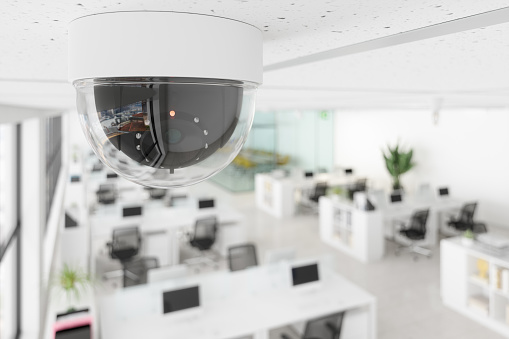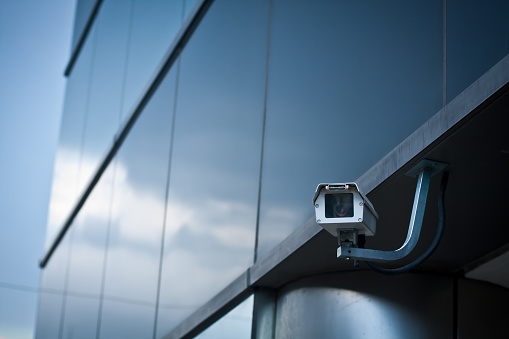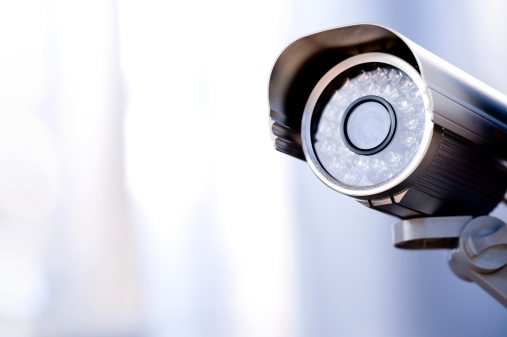The Ultimate Guide to Business Security Cameras

Business Security Cameras: The Ultimate Guide
Your organization juggles multiple priorities daily, from achieving revenue targets to maintaining customer satisfaction. When it comes to video surveillance for your business, researching security camera systems might not be the first concern for business owners, particularly if you’re working remotely. However, gaps in your security impact not only your organization’s performance, but also your people’s livelihoods.
Security Magazine reports that workplace crimes, such as employee theft, cost the average US organization $1.3 million per year in losses.
Furthermore, a third of employees say that they’re unsure of their employers’ emergency preparedness plans, according to a Workplace Safety and Preparedness report.
When it comes to 24-7 security that identifies and deters criminals and silently reassures employees they’re protected, it’s tough to beat a security camera’s offerings.
Business Security Cameras and Workplace Crime
The average organization loses $1.3 million per year to workplace crime
This article about business security cameras covers:
-
The business value of a security camera system
-
What type of camera is best for your organization
-
The criteria you should consider when researching business security cameras

How Business Security Camera Systems Impact your Organization
First and foremost, video surveillance cameras will play a central role in your organization’s security and crime reduction.
For example, organizations worldwide lose approximately five percent of their annual revenue to employee fraud, according to the ACFE. Not investing in proper security systems affects your organization’s performance.
Secondly, camera footage can be invaluable in legal and law enforcement contexts. Both video footage and associated metadata are critical for law enforcement, and both can also be useful for liability. Video surveillance provides visual confirmation of past and present events and has superior capabilities like night vision. This helps with identification, arrests, indictments, and convictions.
Surveillance metadata relates to the video itself. According to SecurityInfoWatch.com, this includes:
-
Time and date stamps
-
Location
-
Analytics content. This includes identifying an individual through facial recognition technology or LPR technology identifying a license plate.
In civil or criminal proceedings, video evidence is useful when there’s an associated chain of custody (CoC). Law enforcement officials have to document and demonstrate who collected, handled, and analyzed evidence, starting with the crime scene itself.
To minimize CoC issues, ensure you’re storing, archiving, and transferring your video surveillance solution with the utmost care. Regarding video evidence in courts, check with your state jurisdiction to make sure it’s admissible and not violating privacy rights.
Thirdly, business security cameras maintain productivity. Your organization’s people, facilities, and assets can be protected, which keeps business operations running smoothly.
Managers can have visibility into employees’ productivity, confirm their health and safety, and help identify suspicious activity. Retail organizations can help bolster their retail security system to ensure their inventory is protected and monitor for shoplifting.
Additionally, the presence of security cameras can help deter intruders. After spotting cameras, they may cease criminal activities or stop before they even get started. A camera’s ability to zoom in to recognize and confirm an intruder’s presence, sound alarms, and capture metadata makes it extremely difficult to circumvent.
The Best Business Camera System Options
Next, figure out what type of camera you need. Two top picks for surveillance cameras are analog and IP (Internet Protocol).
Analog cameras are the typical surveillance cameras you see whenever you enter a business. Analog cameras record images to a video recorder and then send them through a Digital Video Recorder (DVR). These are often black, white, or gray with an orb-like lens.
Different camera varieties include:
-
Bullet
-
Dome
-
Box
Analog cameras are usually simpler to work with than IP surveillance cameras. They’re also easier to install and more widely recognizable. Thanks to motion detection, intruders will know as soon as they set foot onto your property that they’re being monitored. However, they may not have the coverage capabilities that IP surveillance cameras can.
IP cameras, on the other hand, can surveil an area that would require three or four analog cameras. Just one pan-tilt-zoom camera can monitor a large outdoor area as well as zoom in for a highly detailed image. Secondly, they can save you significant costs. Since an IP camera sends data through a Network Video Recorder (NVR), you don’t need the complex cabling and control wires that you would for analog cameras.
An NVR captures your footage in a digital format like a USB or hard drive. Therefore, you can save 50 to 60 percent of the costs with network cables. Their downsides? Setting them up is complicated, requiring skilled technicians. IP camera files also require much more bandwidth.
IP Camera Cost Savings
Network Video Recorder (NVR) can save your business 50 - 60% in surveillance costs

Items of Consideration When You’re Choosing a Security Camera Solution
The following are guidelines for choosing the best business security camera system.
1. Make sure you’re not underestimating or overreaching
Security solutions aren’t one-size-fits-all. The last thing you want is a solution that underperforms or is unnecessarily costly. To right-size your video surveillance investment, establish requisite criteria for your organization.
Start with gauging whether your organization has enough bandwidth to accommodate camera surveillance. The quality of your video will depend on your network’s bandwidth. Higher-resolution cameras usually need more bandwidth. If your bandwidth is too low, it can result in blurry, grainy, low-resolution footage.
Secondly, decide how much camera resolution you need. One determinant is how much space you need to monitor. For example:
-
Are you looking to surveil an entire floor or just a corridor?
-
Do your need your system to simply verify a human’s presence, or do you require one with forensic-grade identification capabilities?
It’s important to have clear, detailed parameters to find a solution that’s the most effective and cost-efficient for your specific organization. Again, your security integrator will provide informed guidance.
2. Narrow down the right storage technologies
Here are four of the best storage options for video:
Digital Video Recorders (DVRs)
DVRs record video in a digital format through either an analog or IP-based recorder. You can search footage by date, time, event, and camera, and even monitor analytics. The advantages of DVRs are that they cost less than other options, can work with existing coaxial cabling, and are simpler to integrate.
One detractor to DVRs is that they can only handle a limited number of physical camera inputs. Another is that they also use a point-to-point connection, requiring more cabling.
Hybrid Video Recorders (HVRs)
These can support analog cameras in conjunction with a small subset of IP cameras. However, they can’t support an array of high megapixel IP cameras.
The plusses are that they can support a few higher-resolution cameras (1080p or greater) and you can monitor them remotely. The minuses are that they cost more than DVRs and require a larger equipment footprint.
Network Video Recorders (NVRs)
NVRs record and process data directly at the camera itself. They’re a software format that records your footage in a digital format. The recorder doesn’t need to be tied to a camera.
You can place NVR units anywhere as long as they’re on the same LAN network as IP cameras. Other advantages are that they can capture HD-quality footage, and don’t require PoE port support.
However, for NVRs to be effective, your network needs to meet their bandwidth requirements. They also offer limited scalability options.
Video Management Software (VMS) Systems
MS systems allow you to use video encoders to add older or existing cameras to your network along with enhanced quality IP cameras. This is an ideal option if you want to add more locations and cameras to your network over time.
VMS Systems can indeed be costlier with more complex UIs. However, they’re a great option if you want to grow your security program along with your business. Because VMS is a robust, scalable system, it’s perfect if you plan to add more cameras and locations to your network over time. They’re built for integration flexibility, and also offer analytics capabilities.

3. Take advantage of the cloud
When cloud technology empowers your business security solutions, it means greater:
-
Accessibility
-
Security
-
Flexibility
Your security won’t be location-based and centralized. Thanks to a cloud-based system, you can monitor your organization’s security on or off-premise from any designated location.
Cloud storage also means that you’ll have an off-site backup of your video data. In case of any threats, unexpected events, or physical damage, you’ll have peace of mind knowing your data’s intact. Best of all, cloud-based security systems are more cost-effective, requiring only a monthly subscription and no upfront purchase costs. Your system should also be able to automatically update itself regularly, saving you from expensive technician upgrade visits.
4. Evaluate integration capabilities
Chances are, you have some effective technology that you’re not yet ready to discard for a new business security system. Therefore, your new technology should be able to function in lockstep with older devices and existing infrastructure.
To accomplish integration, establish a specific plan. Figure out the amount and type of supporting technology you’ll need for your enhanced system.
Some questions to ask yourself, based on guidelines from the Department of Homeland Security, are:
-
Will we require a coaxial cable along with additional power cables?
-
Can we operate off of a LAN alone?
-
Will a wireless router be enough, or will we require PoE?
-
How easily can our software Graphical User Interfaces (GUIs) integrate its controls and displays?
-
What type of vendor support will we need to enable, test, and commission our system integration?
Other broader considerations are:
-
What room configurations will we need?
-
How can we incorporate a good ergonomic design?
-
How will we maintain temperature control and ventilation to ensure the equipment’s longevity?
-
How easily can we upgrade associated parallel systems?
-
What other security systems, like access control or fire protection, do my surveillance system need to co-exist with?
Ideally, you should enjoy a new system’s benefits without sacrificing your existing one’s performance—that is, until you phase out the old technology.
5. Be Deliberate, Thorough, and Find a Knowledgeable Partner
While business security camera systems are imperative, take a strategic and methodical approach when you’re choosing one and not make a hasty selection. For example, building a VMS may be too complex for a smaller organization. A DVR-based solution may not cut it for a large enterprise.
Having established criteria about what your organization specifically needs and can accommodate will steer you to the most effective, economical, and manageable solution.
Want to brush up on security fundamentals? Check out The ABCs of Business Security.
We're Here to Help
Connect with a security expert to find the best security camera solution for your business
Disclaimer: By using the Blog section of this website (“Blog”), you agree to the terms of this Disclaimer, including but not limited to the terms of use and our privacy policy. The information provided on this Blog is for information purposes only. Such information is not intended to provide advice on your specific security needs nor to provide legal advice. If you would like to speak to a Security representative about your specific security needs, please contact us.























